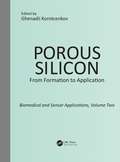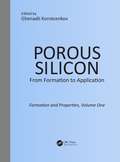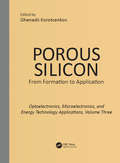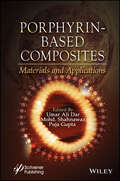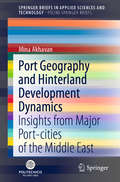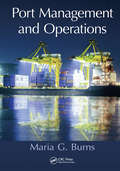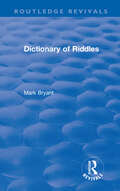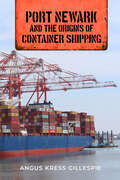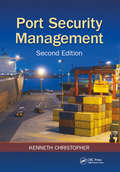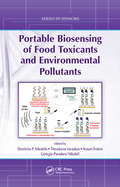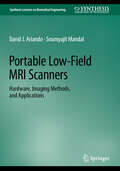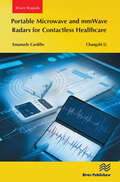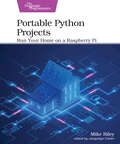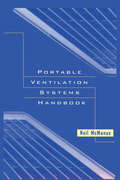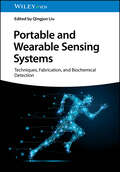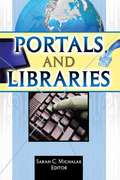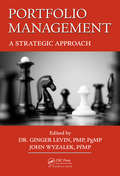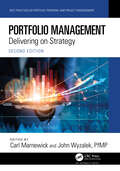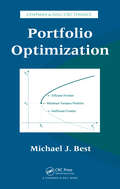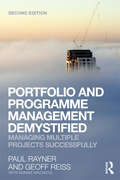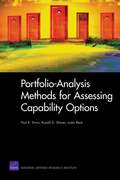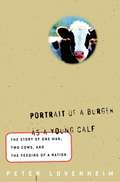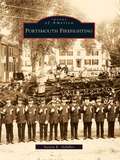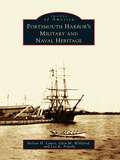- Table View
- List View
Porous Silicon: From Formation to Application: Biomedical and Sensor Applications, Volume Two
by Ghenadii KorotcenkovPorous silicon is rapidly attracting increasing interest from various fields, including optoelectronics, microelectronics, photonics, medicine, chemistry, and biosensing. This nanostructured and biodegradable material has a range of unique properties that make it ideal for many applications. For example, the pores and surface chemistry of the mater
Porous Silicon: From Formation to Application: Formation and Properties, Volume One
by Ghenadii KorotcenkovPorous silicon is rapidly attracting increasing interest in various fields, including optoelectronics, microelectronics, photonics, medicine, chemistry, biosensing, and energy. Porous Silicon: Formation and Properties fills a gap in the literature of the field today, providing a thorough introduction to current knowledge of the formation, processin
Porous Silicon: Opto- And Microelectronic Applications
by Ghenadii KorotcenkovPorous silicon is rapidly attracting increasing interest from various fields, including optoelectronics, microelectronics, photonics, medicine, sensor and energy technologies, chemistry, and biosensing. This nanostructured and biodegradable material has a range of unique properties that make it ideal for many applications. This book, the third of a
Porphyrin-Based Composites: Materials and Applications
by Mohd. Shahnawaz Puja Gupta Umar Ali DarDiscover the transformative potential of porphyrin-based composites in Porphyrin-Based Composites where readers will learn how these innovative materials enhance industrial sectors by combining multiple porphyrin components to create durable, sensitive, and efficient technologies that outperform traditional materials. This book highlights the benefits of adopting porphyrin composites and discusses how they are used in different industrial sectors. Combining multiple porphyrin components is used to create materials with properties that are not possible with individual components, remove restrictions of water-insolubility, and ultimately lead to the development of durable and more sensitive technological materials. Composite materials have been essential to human life for thousands of years, beginning with the construction of houses by the first civilizations and advancing to modern technologies. Originating in the mid-twentieth century, composite materials show promise as a class of engineering materials that offer new opportunities for contemporary technology and have been beneficially incorporated into practically every sector due to their ability to choose elements, tune them to achieve the desired qualities, and efficiently use those features through design. Additionally, composite materials offer greater strength- and modulus-to-weight ratios than standard engineering materials. Materials based on porphyrin composites are used in a wide range of applications, including sensors, molecular probes, electrical gadgets, electronic devices, construction materials, catalysis, medicine, and environmental and energy applications. Readers will find the book: Provides an overview of several porphyrin composites as model materials for commercial settings; Discusses fundamental, experimental, and theoretical research on structural and physicochemical properties of porphyrin composites; Demonstrates how complementary and alternative material designs that use porphyrin composites have evolved; Emphasizes important uses for cutting-edge, multipurpose materials that might contribute to a more sustainable society; Opens new possibilities by examining the role of developing unique hybrid, composite, and higher-order hierarchical materials that may be utilized to make valuable chemicals. Audience Researchers, academicians, chemists, industry experts, and students working in the fields of materials and environmental sciences, engineering, textiles, biology, and medicine.
Port Geography and Hinterland Development Dynamics: Insights from Major Port-cities of the Middle East (SpringerBriefs in Applied Sciences and Technology)
by Mina AkhavanThis book illustrates and discusses the main characteristics of port-city development dynamics with a focus on the fast-growing city-states of the Middle East, which are emerging as key players in logistics and the global supply chain. Maritime ports and the cities hosting them have long fascinated scholars – geographers, economists, architects, urban planners, sociologists etc. – as they become centres of exchange where different social and urban environments meet, at the intersection between land and sea. Given that the current body of literature on the topic is biased – mainly concerning the Western world and East Asian region – with mono-disciplinary tendencies, this book outlines a theoretical basis from a wide range of literature, linking port-city studies, globalization theories and logistics, and adopts a multidisciplinary perspective. The main target audience of the book includes scholars and graduate students in urban studies, spatial planning, urban and regional economics, logistics, geography and transport geography with an interest in studying port geography and the port-city interface, port infrastructure development and port hinterland dynamics; it will also benefit policymakers and urban planners whose work involves these topics.
Port Management and Operations
by Maria G. BurnsWith 80 percent of the world’s commodities being transported by water, ports are the pillars of the global economy. Port Management and Operations offers readers the opportunity to enhance their strategic thinking and problem-solving skills, while developing market foresight. It examines global port management practices at the regulatory, commercial, technological, operational, financial, and sociopolitical levels.This powerful sourcebook describes how seaports are being affected by the changes occurring nationally, regionally, and globally. Evaluating the new regulatory framework, it pinpoints the industry’s implementation readiness and identifies potential problem areas. The book classifies the spectrum of interrelated port management principles, strategies, and activities in a logical sequence and under four cornerstones—Port Strategy and Structure, Legal and Regulatory Framework, Input: Factors of Production, and Output and Economic Framework.Detailing best practices and the latest industry developments, the book highlights emerging challenges for port managers and identifies opportunities to develop forward-thinking strategies. It examines the effectiveness of current strategies, tactics, tools, and resources of numerous global ports and highlights the necessity of adopting a proactive stance in harmonizing the laws, regulations, and policies pertaining to the maritime, oil, and gas industries.The shipping industry has myriad complexities and this book provides maritime managers and professionals with the wide-ranging and up-to-date understanding required to thrive in today’s highly competitive and evolving environment.
Port Management and Operations
by Maria G. BurnsWith 80 percent of the world’s commodities being transported by water, ports are the pillars of the global economy. Port Management and Operations offers readers the opportunity to enhance their strategic thinking and problem-solving skills, while developing market foresight. It examines global port management practices at the regulatory, commercial, technological, operational, financial, and sociopolitical levels.This powerful sourcebook describes how seaports are being affected by the changes occurring nationally, regionally, and globally. Evaluating the new regulatory framework, it pinpoints the industry’s implementation readiness and identifies potential problem areas. The book classifies the spectrum of interrelated port management principles, strategies, and activities in a logical sequence and under four cornerstones—Port Strategy and Structure, Legal and Regulatory Framework, Input: Factors of Production, and Output and Economic Framework.Detailing best practices and the latest industry developments, the book highlights emerging challenges for port managers and identifies opportunities to develop forward-thinking strategies. It examines the effectiveness of current strategies, tactics, tools, and resources of numerous global ports and highlights the necessity of adopting a proactive stance in harmonizing the laws, regulations, and policies pertaining to the maritime, oil, and gas industries.The shipping industry has myriad complexities and this book provides maritime managers and professionals with the wide-ranging and up-to-date understanding required to thrive in today’s highly competitive and evolving environment.
Port Management and Operations (Routledge Revivals Ser.)
by Maria G. BurnsWith 80 percent of the world’s commodities being transported by water, ports are the pillars of the global economy. Port Management and Operations offers readers the opportunity to enhance their strategic thinking and problem-solving skills, while developing market foresight. It examines global port management practices at the regulatory, commercial, technological, operational, financial, and sociopolitical levels.This powerful sourcebook describes how seaports are being affected by the changes occurring nationally, regionally, and globally. Evaluating the new regulatory framework, it pinpoints the industry’s implementation readiness and identifies potential problem areas. The book classifies the spectrum of interrelated port management principles, strategies, and activities in a logical sequence and under four cornerstones—Port Strategy and Structure, Legal and Regulatory Framework, Input: Factors of Production, and Output and Economic Framework.Detailing best practices and the latest industry developments, the book highlights emerging challenges for port managers and identifies opportunities to develop forward-thinking strategies. It examines the effectiveness of current strategies, tactics, tools, and resources of numerous global ports and highlights the necessity of adopting a proactive stance in harmonizing the laws, regulations, and policies pertaining to the maritime, oil, and gas industries.The shipping industry has myriad complexities and this book provides maritime managers and professionals with the wide-ranging and up-to-date understanding required to thrive in today’s highly competitive and evolving environment.
Port Newark and the Origins of Container Shipping
by Angus Kress GillespieContainer shipping is a vital part of the global economy. Goods from all around the world, from vegetables to automobiles, are placed in large metal containers which are transported across the ocean in ships, then loaded onto tractor-trailers and railroad flatbeds. But when and where did this world-changing invention get started? This fascinating study traces the birth of containerization to Port Newark, New Jersey, in 1956 when trucker Malcom McLean thought of a brilliant new way to transport cargo. It tells the story of how Port Newark grew rapidly as McLean’s idea was backed by both New York banks and the US military, who used containerization to ship supplies to troops in Vietnam. Angus Gillespie takes us behind the scenes of today’s active container shipping operations in Port Newark, talking to the pilots who guide the ships into port, the Coast Guard personnel who help manage the massive shipping traffic, the crews who unload the containers, and even the chaplains who counsel and support the mariners. Port Newark shines a spotlight on the unsung men and women who help this complex global shipping operation run smoothly. Since McLean's innovation, Port Newark has expanded with the addition of the nearby Elizabeth Marine Terminal. This New Jersey complex now makes up the busiest seaport on the East Coast of the United States. Some have even called it “America’s Front Door.” The book tells the story of the rapid growth of worldwide containerization, and how Port Newark has adapted to bigger ships with deeper channels and a raised bridge. In the end, there is speculation of the future of this port with ever-increasing automation, artificial intelligence, and automation.
Port Security Management
by Kenneth Christopher Steven B. FfflmSea and freshwater ports are a key component of critical infrastructure and essential for maintaining global and domestic economies. In order to effectively secure a dynamic port facility operation, one must understand the business of maritime commerce. Following in the tradition of its bestselling predecessor, Port Security Management, Second Edit
Portable Biosensing of Food Toxicants and Environmental Pollutants (Series in Sensors)
by Dimitrios P. Nikolelis Georgia-Paraskevi Nikoleli Theodoros Varzakas Arzum ErdemBiosensors are poised to make a large impact in environmental, food, and biomedical applications, as they clearly offer advantages over standard analytical methods, including minimal sample preparation and handling, real-time detection, rapid detection of analytes, and the ability to be used by non-skilled personnel. Covering numerous applications
Portable Low-Field MRI Scanners: Hardware, Imaging Methods, and Applications (Synthesis Lectures on Biomedical Engineering)
by Soumyajit Mandal David J. AriandoThis book provides readers with an accessible and up-to-date introduction to the field of low-field MRI, which is currently seeing a resurgence in both research and commercial activity. It begins by presenting a historical overview of MRI system design and discussing current developments. It then analyzes the underlying physics of MRI from a semi-classical perspective before describing the major hardware components of low-field scanners (including the magnet, coils, transmitters, receivers, gradient systems, and digital processors) in detail. Several examples of each component are described to solidify the reader’s understanding of the major challenges and trade-offs involved in designing these complex devices. Finally, the issues involved in integrating these components within a working system are highlighted by presenting the architecture, design, and test results of two fully functional low-field MRI scanners that were designed and developed by the authors.
Portable Microwave and mmWave Radars for Contactless Healthcare
by Emanuele Cardillo Changzhi LiThis book is dedicated to modern radars, describing their working principles and providing an overview on recent applications of microwave and mmWave radars for healthcare applications.For many years, the scientific community has put significant effort into the development of advanced microwave and mmWave radar systems for healthcare applications. Young students, researchers, and professionals need a reference book which clearly and concisely describes the main principles of portable radars and identify the relevant applications of this technology.This book is both an entry point for students and researchers new to the topic and a reference for those seeking to explore specific aspects of radar technologies in healthcare. Ultimately, the authors hope to inspire joint efforts directed towards new innovative theories, technologies, techniques, and applications of modern biomedical radar.
Portable Python Projects: Run Your Home On A Raspberry Pi
by Mike RileyDiscover easy ways to control your home with the powerful new Raspberry Pi hardware. Program short Python scripts that will detect changes in your home and react with the instructions you code. Use new add-on accessories to monitor a variety of measurements, from light intensity and temperature to motion detection and water leakage. Expand the base projects with your own custom additions to perfectly match your own home setup. Most projects in the book can be completed in under an hour, giving you more time to enjoy and tweak your autonomous creations. No breadboard or electronics knowledge required! Get to know the latest Raspberry Pi hardware, and create awesome automation solutions for home or work that don't require an electronics degree, cumbersome add-ons, or expensive third-party subscription services. Create easy to run Python scripts on your own that make your Pi do things that would have required a team of automation experts to build only a few years ago. Connect to and control popular home automation lighting systems from a Raspberry Pi. Trigger autonomous actions based on movement, temperature, and timer events. Power on your own computer and appliances using your voice. Remotely control infrared-enabled consumer electronics, create chatbots to retrieve personalized items of interest, and implement a temperature-monitoring room fan. These are just some of the projects that the book will show you how to make. Most projects can be completed and operational in under an hour, and do not require any messy schematics or a spaghetti bowl of wires and breadboard-attached circuits to operate. Control your home or office exactly the way you want instead of relying on an expensive mysterious box of third-party technology to do it for you. What You Need: Raspberry Pi (Pi 4 Model B or higher recommended) running Raspberry Pi OS
Portable Ventilation Systems Handbook
by Neil McManusPortable ventilation systems provide an option for supplementing installed ventilation, as well as providing a system for ventilation where none exists. Portable Ventilation Systems Handbook discusses the various types of portable ventilation systems currently in use, their advantages and disadvantages, and what systems works best for what function.
Portable and Wearable Sensing Systems: Techniques, Fabrication, and Biochemical Detection
by Qingjun LiuPortable and Wearable Sensing Systems Discover the sensors of the future with this comprehensive guide Chemical sensors and biosensors have advanced enormously in recent decades, driven by growth in other technological areas and the refinement of manufacturing processes. Advances, especially, in wireless technology and flexible electronics have dramatically increased the practicality and availability of portable or wearable sensing systems. These have the potential to revolutionize disease diagnosis, food analysis, and environment monitoring at the point of care. Portable and Wearable Sensing Systems: Techniques, Fabrication, and Biochemical Detection introduces these groundbreaking technologies and the underlying principles which make them possible. Beginning with an overview of the foundational optics and electrochemistry which power these systems, the book surveys methods of fabrication, applications, and projected future developments. The result is a comprehensive introduction to an essential medical and biochemical technology. Portable and Wearable Sensing Systems readers will also find: Treatment of body fluid detection, exhaled breath sensing, ingestible devices, and moreDetailed discussion of sensing system types including scattering, colorimetric, and chemiluminescenceForward-looking attention to the latest advances in every chapter Portable and Wearable Sensing Systems is ideal for analytical chemists, materials scientists, bioengineers, biochemists, and anyone working with sensing technologies.
Portals and Libraries
by Sarah C. MichalakCutting-edge information about providing access to research library usersThe ultimate goal of librarians is to provide comprehensive informational access to library users. Portals and Libraries provides an in-depth look at various libraries&’ challenges and the cutting-edge technology used in providing high-quality electronic access to users through portal systems. Respected authorities detail efforts to build a new kind of search and retrieval system that includes access to the Web as well as other vital collections and academic resources. The book discusses the implementation of access systems and their supporting technology, and spotlights strategies designed to encourage quality system-user feedback, increase the cooperation and diligence of staff, and more. Portals and Libraries comprehensively reviews library portals from their roots to their current state, with a look at assorted products, their implementation issues, and each one&’s advantages and shortcomings. The overall state of the portal system today as well as where it is heading in the future is examined in detail. The book also provides the ARL Scholars Portal Working Group Final Report from May 2002 summarizing the group&’s work from its inception, and includes their recommendations of key portal features and needed functions. The text includes helpful screenshots, useful descriptive figures, and extensive references.Portals and Libraries discusses: the history of library portals the MyLibrary@NCState Web portal after five years of use "Portals to the World" Library of Congress guide to Web resources the role integrated library systems will play in the future of portals features and services to be added to library portals for greater success portal technologies-their structures and functioning planning portal implementation online catalogs usability testing and interface design nine key issues that will impact the future of portal developmentPortals and Libraries is crucial reading for library educators and students, college and research librarians in reference, library system professionals, and technical services professionals focused on applying cutting-edge technology to library services.
Portfolio Management: A Strategic Approach (Best Practices In Portfolio, Program, And Project Management Ser. #17)
by Ginger Levin; John WyzalekRecognizing the importance of selecting and pursuing programs, projects, and operational work that add sustainable business value that benefits end users, the Project Management Institute (PMI) issued its first Standard on Portfolio Management in 2006. In 2014, it launched the Portfolio Management Professional (PfMP) credential-which several of the
Portfolio Management: Delivering on Strategy (Best Practices in Portfolio, Program, and Project Management #17)
by Carl Marnewick John WyzalekPortfolio management is becoming the ‘must have’ for organizations to prosper and survive in this decade and beyond. No longer can the organizational focus be one of following best and repeatable practices as resource limitations mean only those programs, projects, and operational work that add business value can and should be pursued. Executives are focusing on strategic ability and managing complexity, which can only be done through a disciplined portfolio process in ensuring the best mix of programs, projects, and operational work is under way. In turn, the portfolio is constantly in flux as difficult decisions are made if a project, for example, is no longer contributing to business value and providing benefits and should be terminated to reallocate resources to one of higher priority. Commitment to this difficult approach is necessary at all levels, and communication is required so everyone knows how their work contributes to the organization’s strategic goals and objectives. Portfolio Management: Delivering on Strategy, Second Edition focuses on the benefits of portfolio management to the organization. Its goal is to provide senior executives a view on how portfolio management can deliver organizational strategy. The emphasis is on the specific aspects within the portfolio management discipline and how each aspect should be managed from a business perspective and not necessarily from a portfolio management perspective. Highlights of the book include: Agile portfolio management Delivering organizational value Portfolio management and uncertainty Portfolio governance Marketing a portfolio Portfolio management success Starting with a review of the project portfolio concept and its development, this book is a reference for executives and practitioners in the field, as well as a students and researchers studying portfolio management.
Portfolio Optimization (Chapman and Hall/CRC Financial Mathematics Series)
by Michael J. BestEschewing a more theoretical approach, Portfolio Optimization shows how the mathematical tools of linear algebra and optimization can quickly and clearly formulate important ideas on the subject. This practical book extends the concepts of the Markowitz "budget constraint only" model to a linearly constrained model.Only requiring elementary linear algebra, the text begins with the necessary and sufficient conditions for optimal quadratic minimization that is subject to linear equality constraints. It then develops the key properties of the efficient frontier, extends the results to problems with a risk-free asset, and presents Sharpe ratios and implied risk-free rates. After focusing on quadratic programming, the author discusses a constrained portfolio optimization problem and uses an algorithm to determine the entire (constrained) efficient frontier, its corner portfolios, the piecewise linear expected returns, and the piecewise quadratic variances. The final chapter illustrates infinitely many implied risk returns for certain market portfolios.Drawing on the author’s experiences in the academic world and as a consultant to many financial institutions, this text provides a hands-on foundation in portfolio optimization. Although the author clearly describes how to implement each technique by hand, he includes several MATLAB® programs designed to implement the methods and offers these programs on the accompanying downloadable resources.
Portfolio and Programme Management Demystified: Managing Multiple Projects Successfully
by Geoff Reiss Paul RaynerYou’re now responsible for a programme, or you’ve got a portfolio to manage? Where do you start? Right here! Projects are not simply the bread and butter of an organisation. Form them into programmes or portfolios and they can be prioritised and integrated to deliver change to your organization in line with your strategic vision. You will be able to control costs and risks and bring together a complex series of themes effectively. This overhauled second edition now combines portfolio management as a parallel theme with programme management, and it is brought in line with the current thinking of the Association for Project Management and the Project Management Institute. It is written for managers in both the public and private sectors. This new edition includes half a dozen short case studies (from Belgium’s Fortis Bank, a software company, local government, and central government), along with more on cross-functional management. Together with Project Management Demystified, also from Routledge (third edition, 2007), it provides the tools to manage your projects, your programmes and your portfolio to a very high level.
Portfolio-Analysis Methods for Assessing Capability Options
by Justin Beck Paul K. Davis Russell D. ShaverAn analytical framework and methodology for capability-area reviews is described, along with new tools to support capabilities analysis and strategic-level defense planning in the Defense Department and the Services. BCOT generates and screens preliminary options, and the Portfolio-Analysis Tool (PAT) is used to evaluate options that pass screening. The concepts are illustrated with applications to Global Strike and Ballistic Missile Defense. Recommendations are made for further defense-planning research.
Portrait of a Burger as a Young Calf: The True Story of One Man, Two Cows, and the Feeding of a Nation
by Peter LovenheimWhen Lovenheim's young daughter asks where hamburger comes from, he sets out to find a detailed answer to her question. He visits farms in New York state and buys two beef calves to follow through the beef production process. He presents a lot of information in a way which is clear and readable. He treats the farmers' actions and decision with respect and compassion even when he is dealing with the hard lives of the animals and their keepers. The author shares his own struggles concerning the slaughter of animals especially his own two cows. He interviews folks who revere cows and those who relish their best steaks. Excellent descriptions. Possibly a bleak subject, but definitely a captivating book.
Portsmouth Firefighting (Images of America)
by Steven E. AchillesIn September 1756, with only fire buckets, two hand tubs, and citizen volunteers safeguarding the Colonial seaport, Portsmouth decided to organize and regulate its fire protection. By 1852, the Portsmouth Fire Department boasted six suction engines and in 1864 entered the age of steam power when the first steam fire engine was delivered. Disastrous fires and a growing city required the department to modernize as it moved into the 20th century. The department's first motorized engine was purchased in 1912, and by 1921, there was a new central fire station along with a new gasoline-powered ladder truck. Through an exceptional collection of photographs, Portsmouth Firefighting richly illustrates the story and tradition of a fire department forever connected to its brave firefighters, their magnificent fire engines, and the spectacular blazes they fought.
Portsmouth Harbor's Military and Naval Heritage (Images of America)
by Glen M. Williford Leo K. Polaski Nelson H. LawryIncluding more than two hundred vintage photographs and illustrations, Portsmouth Harbor's Military and Naval Heritage chronicles the history of the Piscataqua River's naval shipyard and harbor defenses. Long before it became home to one of the U.S. Navy's first federal shipyards, the harbor at Portsmouth, New Hampshire, and Kittery, Maine, was protected by gun batteries, mainly at Fort Point, New Castle, New Hampshire. By the end of World War II, modern concrete batteries mounting guns of ever longer range had been constructed at this and three other forts straddling the river's mouth. These fortifications reflected the increasingly important role of the shipyard, dedicated after 1917 to building submarines that contributed significantly to the World War II victory.
